How To Force Vs Nuget To Re-Download Packages UPDATED
How To Force Vs Nuget To Re-Download Packages
Consume NuGet packages
Yous can install, update, and remove NuGet packages via the NuGet window Alt+Shift+7 and NuGet quick list Alt+Shift+N.
Scan installed and available NuGet packages
By default, the Packages tab of the window shows all packages installed in the whole solution, but you can change the view to only prove packages of a specific projection. To do so, apply the telescopic selector next to the search box:
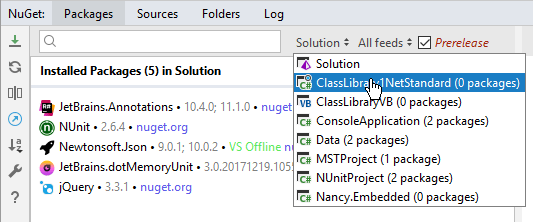
Available packages for the selected telescopic are always shown beneath the installed packages.
Packages that are referenced from other installed packages are displayed in the Implicitly Installed category. Their versions are shown in brackets because you lot cannot upgrade or downgrade them. To larn which package references an implicitly installed one, correct-click it and choose Quick NuGet Documentation or press Ctrl+Q.
Yous can select installed or available packages in the left function of the Packages tab, and use the right part to check parcel details, as well every bit to install, upgrade/downgrade, or remove the package in specific projects:
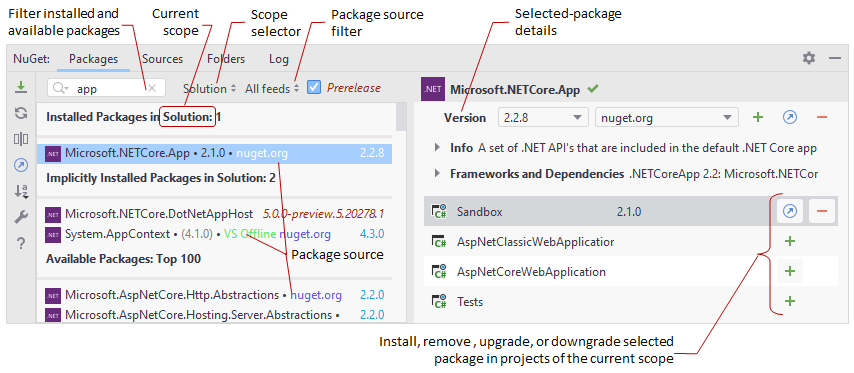
Restore and Upgrade NuGet packages
Rider provides two algorithms for restoring NuGet packages:
-
Normal — calls the standard NuGet restore mechanism, which tin can be slow, especially on .NET Core projects. It is available in the primary menu (), in the NuGet quick listing Alt+Shift+N, and past clicking Restore
 on the NuGet window toolbar.
on the NuGet window toolbar. -
Force — performs a number of heuristics to determine which packages should be restored. The 'Force' algorithm works about instantaneously, however at that place could exist cases where it fails to restore some packages.
We recommend using force restore for large projects. It is available in the primary menu () or in the NuGet quick listing Alt+Shift+N.
When you open up a solution, Passenger will automatically apply the 'Calorie-free' algorithm to restore missing packages. If necessary, you can change the auto-restore behaviour on the NuGet settings folio, which you can also open by clicking NuGet Settings ![]() on the NuGet window toolbar.
on the NuGet window toolbar.
To upgrade the installed packages, click Upgrade Packages in Solution ![]() on the NuGet window toolbar and then choose which packages should be upgraded.
on the NuGet window toolbar and then choose which packages should be upgraded.
Alternatively, you lot tin select one of the installed packages in the left-manus side of the NuGet window choose the desired version in the right part, and so upgrade/downgrade specific projects to this bundle version.
Find and install NuGet packages
To find a NuGet parcel, use the search field and the list of Available packages, which appears under the list of Installed packages.
In the search field, you can enter a packet name to await for or use prefixes: T: to look for types and Due north: to expect for namespaces.
Past default, Rider searches all available parcel sources, but you lot can limit the search scope using the corresponding selector:
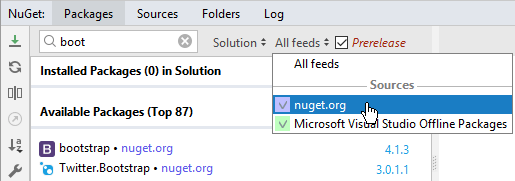
A single click on a packet source will select the source and deselect all others. Y'all can Shift -click to select multiple sources or click All feeds to select all.
Install or upgrade/downgrade a NuGet package
-
Find the desired package equally described above and select it in the left part of the Packages tab
-
In the right part of the tab, cull a project where you want to install the selected package. If your solution contains too many projects, you may want to utilize the scope selector on the toolbar to brandish specific project and hide all others.
-
Utilize the Prerelease checkbox on the toolbar to show or hide pre-release versions of the package.
-
Use the Version selector in the right tab to cull the desired version of the package.
-
Before installing the selected package, yous may want to bank check which dependent packages will exist installed. To do so, expand Frameworks and Dependencies in the right role:
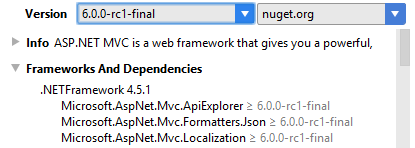
-
Depending on the selected bundle version, and on whether the selected package is installed in the selected project, you volition be able to install, upgrade or downgrade the packet.
Subsequently installing a new packet, you will encounter it's readme.txt file in the editor so that you will be able to cheque if any additional steps are required after installing.
If config file/XDT transformations are implemented in the package, JetBrains Rider will run them to aid in adding required entries, for example to an App.config or Web.config file.
The easiest way to start the search for a NuGet parcel is to use the corresponding Alt+Enter action that becomes available for unresolved namespaces:
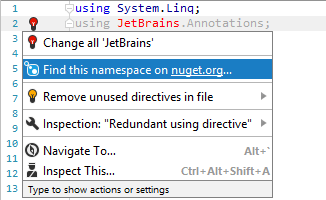
... and types:
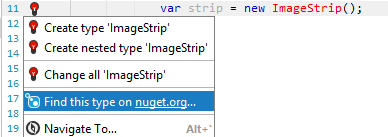
In any example, JetBrains Passenger will open up the NuGet window, where y'all will see all packages that incorporate the desired type or namespace.
Manage bundle sources
In the Sources tab of the NuGet window, Rider lists all NuGet configuration files discovered on your machine. You tin can add, remove, or edit package sources for the selected config file on the right panel, or click these files to open up them in the editor.
If necessary, yous can add or remove package sources manually, past editing the packageSources section of a configuration file. For example:
<packageSources> <add key="My online packet source" value="https://some.address/"/> <add central="My local packet source" value="C:\NuGetPackages\"/> </packageSources>
Credential providers for private NuGet feeds
JetBrains Rider lets you lot cosign to individual NuGet feeds that use with different authentication methods.
Authentication prompt for username/password combination
In the Sources tab of the NuGet window, you can edit or add a feed and add together credentials in the form of a username/password combination.
The URL to private feeds is oftentimes shared with team members in the NuGet.config file that sits next to the solution file, so that anybody on the team tin connect to such private feed. On the commencement load of such solution where bundle restore is required, JetBrains Rider volition prompt for credentials.
When credentials are correct, they are stored in JetBrains Rider's password store so that you don't have to re-enter credentials each fourth dimension yous access a NuGet feed. The password store is configurable on the Appearance and Beliefs | System Settings | Passwords page of the IDE settings Ctrl+Alt+South.
JetBrains Rider also has integrated credential providers for MyGet and Visual Studio Squad Services (VSTS).
Use hallmark plugins
For private feeds that use plugin-based hallmark method, such as the 1 provided by Azure Artifacts, you demand to change the Use credential providers preference on the Build, Execution, Deployment | NuGet page of the IDE settings Ctrl+Alt+S to NuGet/.Cyberspace CLI plugins or to NuGet/.NET CLI plugins, then Rider integrated (if you use different authentication methods) and and so restart JetBrains Rider.
In one case authentication plugins back up is enabled, the %USERPROFILE%\.nuget\plugins (Windows) and $HOME/.nuget/plugins (Linux/macOS) path will be monitored for credential provider plugins that are applicable, and JetBrains Rider will use those to perform necessary authentications.
NuGet options
You can configure NuGet preferences in the NuGet settings page, which you can open by clicking NuGet Settings ![]() in the NuGet window or by choosing in Passenger settings Ctrl+Alt+S.
in the NuGet window or by choosing in Passenger settings Ctrl+Alt+S.
In the Search section, yous tin can choose:
-
Include prerelease — lets you search and install pre-release versions of packages. This preference is synchronized with the same preference shown on the toolbar of the Packages tab.
-
Include unlisted — lets you search and install versions of packages that are at unlisted on the server (for case, at NuGet website). You may want to use this pick to see outdated versions of packages.
Preferences in the Install and Update and in Uninstall sections work exactly the same as in Visual Studio packet manager:
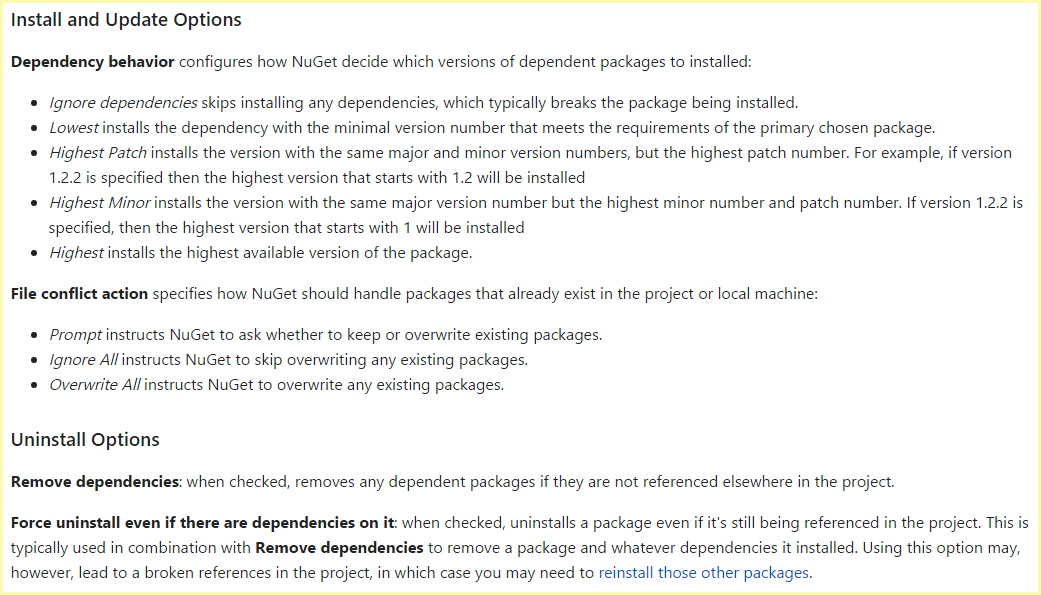
Manage NuGet caches
NuGet caches all downloaded packages to make them available when there is no net connection and to prevent multiple downloads of the same packet.
With Rider, you can view locations of NuGet caches and clear selected locations in the Folders tab of the NuGet window. Immigration NuGet caches is safe, it does not bear on packages installed in your projects.
Edit NuGet configuration files
If necessary, yous tin can also manually edit NuGet configuration files — NuGet.Config, packages.config, and *.nuspec. Most of the coding assistance features including syntax validation and Lawmaking completion (IntelliSense) are there for you.

NuGet quick list
The well-nigh often used actions are bachelor in the NuGet quick list — Alt+Shift+N or :
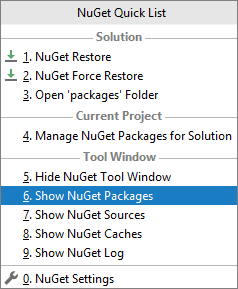
Terminal modified: 17 February 2022
DOWNLOAD HERE
Posted by: cookfrach1975.blogspot.com

Post a Comment for "How To Force Vs Nuget To Re-Download Packages UPDATED"